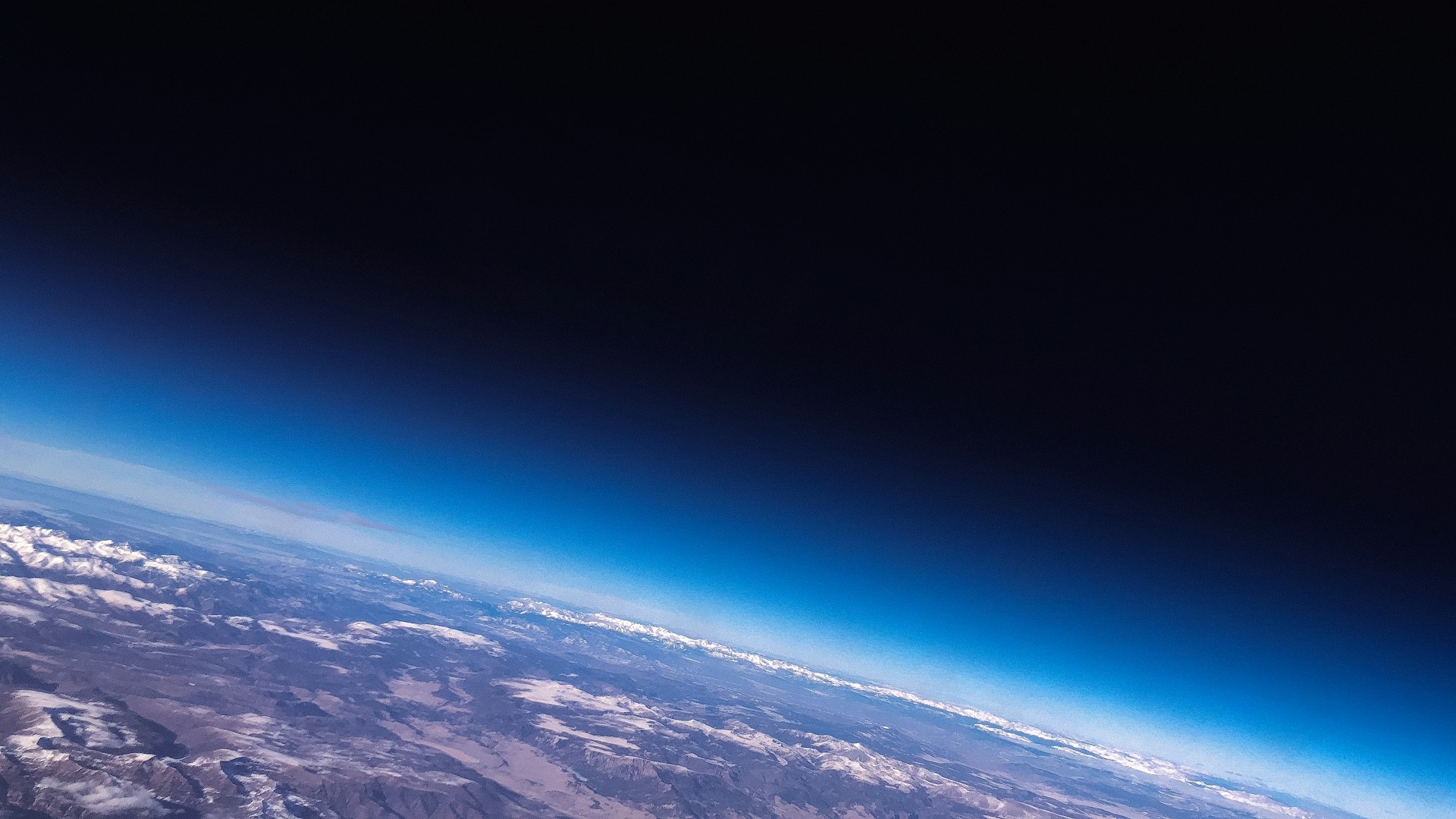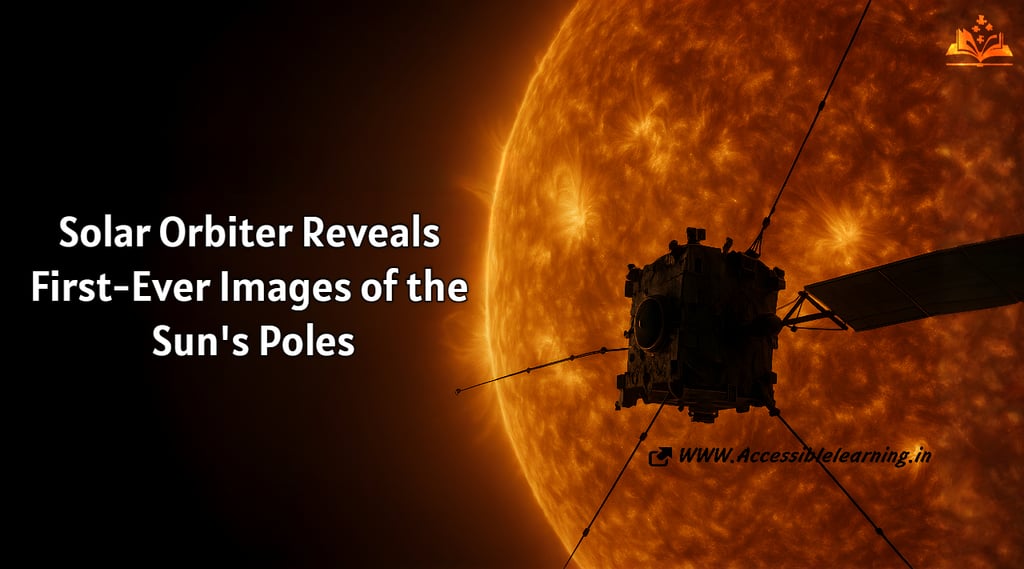
Solar Orbiter Spacecraft Obtains First Images of the Sun's Poles
Solar Orbiter captures the first-ever images of the Sun’s poles, offering groundbreaking insights into magnetic fields, solar cycles, and space weather forecasting.
NEWS/CURRENT AFFAIRSSPACE/TECHEDUCATION/KNOWLEDGE
Sachin K Chaurasiya
6/15/20255 min read


In a historic milestone for solar science, the European Space Agency’s (ESA) Solar Orbiter spacecraft has captured the first-ever detailed images of the Sun’s poles, a region that has long eluded direct observation. This unprecedented achievement opens new frontiers in solar research and may help scientists unravel the complex mysteries of solar activity, such as the 11-year solar cycle, space weather phenomena, and magnetic field reversals.
A New Angle on an Old Giant: Why the Poles Matter
The Sun’s north and south poles play a crucial role in the generation of its powerful magnetic field. However, these regions have remained invisible to telescopes orbiting within the plane of the solar system—until now.
Understanding the sun’s poles is key to unlocking
The dynamics of the solar dynamo—the internal mechanism that drives magnetic field changes.
How and why the solar magnetic poles flip approximately every 11 years.
The formation of solar winds and coronal mass ejections (CMEs) that impact Earth’s atmosphere, satellites, and power grids.
Meet Solar Orbiter: Europe’s Mission to Touch the Sun
Launched in February 2020, Solar Orbiter is a joint mission between ESA and NASA with a unique mission: to get close to the Sun and view it from high solar latitudes.
Equipped with 10 state-of-the-art instruments, Solar Orbiter combines in-situ measurements (like magnetic fields and particle flows) with remote sensing tools (high-res imagers, ultraviolet spectrometers, and more).
Notably, its elliptical orbit—aided by multiple gravity assists from Earth and Venus—allows it to tilt gradually out of the ecliptic plane, giving it a rare view of the Sun’s poles.
First Polar Images: A Stunning Scientific Treasure
In mid-2024, Solar Orbiter reached a tilt of about 33 degrees, enough to begin imaging the polar regions with clarity never achieved before. Some highlights:
Magnetic Flux Filaments observed swirling vertically around the poles.
Clearer mapping of the polar coronal holes—sources of fast solar wind streams.
New views of solar “”campfires”—mini solar flares—behaving differently at higher latitudes.
These images were captured using Solar Orbiter’s Polarimetric and Helioseismic Imager (PHI) and Extreme Ultraviolet Imager (EUI). The data is already being compared with models of the Sun's inner dynamo system.
Scientific Significance: From Theory to Prediction
The new images have already prompted a reevaluation of existing magnetic field models. By correlating polar activity with in-situ solar wind measurements, scientists now hope to:
Improve solar storm forecasting—crucial for space missions and satellite networks.
Refine our understanding of the heliospheric current sheet, the "wavy" magnetic surface that spans the solar system.
Enhance climate modeling on Earth by better tracking long-term solar irradiance variations.
Global Collaboration: A Unified Vision of Space Exploration
This achievement is not just a feather in ESA’s cap. NASA, research centers across Europe, and academic institutions globally have contributed to the mission’s success. Open-source data sharing has ensured rapid scientific feedback loops.
What’s Next for Solar Orbiter?
Solar Orbiter will continue increasing its orbital inclination to up to 37 degrees in the next few years. As it nears solar maximum around 2025–2026, the spacecraft is expected to capture even more dynamic and high-resolution images of polar activity—including solar pole reversals.
Additionally, its proximity to the Sun (as close as 0.28 AU—about a quarter of the distance between Earth and the Sun) enables it to complement NASA’s Parker Solar Probe, which dives even closer but lacks imaging tools.
Human-Centered Reflections: Why This Matters to Us
In a world increasingly dependent on satellites, GPS, and power grids, understanding the Sun is not just an academic endeavor. Solar Orbiter’s findings directly contribute to space weather preparedness, technological resilience, and even astronaut safety during future lunar and Martian missions.
Moreover, the awe-inspiring images from our solar star’s hidden regions rekindle the human spirit of exploration—reminding us that even in the age of AI and automation, the cosmos still holds endless wonder.

“First Light” from a New Solar Perspective
While early test images from 2020 already amazed scientists, the polar images in 2024 marked the first time humanity looked at the sun “from above.” These aren’t just first-time images—they are first-time insights into magnetic symmetry, showing how polar dynamics differ radically from equatorial activity.
Clues to the Solar Flip: Predicting Magnetic Reversals
The Sun flips its magnetic field every 11 years, yet the precise timing and triggers of this reversal have always been mysterious. The new images show early magnetic loop formations and asymmetries at each pole—which could help scientists predict the polarity switch more accurately and even forecast the next solar minimum or maximum with greater precision.
Detection of ‘Open Magnetic Field Lines’
Solar Orbiter has confirmed the existence of open magnetic field lines—particularly at the poles—which allow high-energy particles to escape into the heliosphere. This finding supports theories that the polar coronal holes are major launch zones for the fast solar wind, which can impact space weather all the way to Earth.
Hi-Def Polar Vortices & Unseen Swirls
New extreme ultraviolet imaging revealed whirlpool-like magnetic structures near the “poles”—polar vortices—which “appear to influence the global magnetic balance.” These were previously only predicted in simulations but are now confirmed, offering new avenues to model solar behavior in 3D.
Solar Orbiter Relays Clues About Cosmic Rays
Interestingly, the polar regions may be linked to the modulation of galactic cosmic rays—high-energy particles from outside the solar system. The strength and orientation of the polar magnetic fields affect how much cosmic radiation enters the solar system, and understanding this interaction can improve astronaut safety and shielding technology for deep space travel.
Autonomous Solar Imaging: AI Onboard
Solar Orbiter uses AI algorithms onboard to autonomously prioritize which images to send back due to limited bandwidth. The spacecraft doesn’t stream data like a webcam; instead, it smartly decides which phenomena (e.g., flares, anomalies) are most important—making it one of the first intelligent imaging platforms in space exploration.
Polar Magnetic “Memory” Zones
One surprising finding is that the Sun's poles seem to retain traces of past magnetic cycles—almost like a magnetic “memory.” By studying these remnants, researchers hope to build a continuous timeline of solar magnetic evolution, going beyond what sunspot records alone can tell us.
FAQ
Is this the first mission to observe the Sun’s poles?
Yes, it's the first to capture direct high-resolution images from an out-of-ecliptic angle.
What technology enabled this breakthrough?
A combination of gravity assists, polar imagers, and a non-equatorial orbit made this possible.
Can these findings predict solar storms?
Yes—the data helps refine models that forecast solar eruptions and their impact on Earth.
What’s the difference between Solar Orbiter and Parker Solar Probe?
Parker gets closer to the Sun but can’t take pictures. Solar Orbiter provides images, especially from unique angles like the poles.
Where can I view these images?
Visit ESA’s Solar Orbiter Mission Portal for real-time images and updates.
As we face a world both illuminated and challenged by our sun’s moods, the Solar Orbiter's eyes on the poles remind us how much we still have to learn—and how far humanity has come in reaching for the light.
Subscribe to our newsletter
All © Copyright reserved by Accessible-Learning
| Terms & Conditions
Knowledge is power. Learn with Us. 📚


